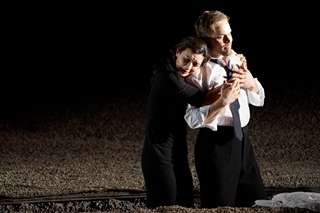|
Back
A lesson in simple eloquence Toronto
The Four Seasons Centre for the Performing Arts
05/08/2011 - and May 11*, 14, 17, 20, 24, 26, 28, 2011
Christoph Willibald Gluck: Orfeo ed Euridice
Lawrence Zazzo (Orfeo), Isabel Bayrakdarian (Euridice), Ambur Braid (Amor)
The Canadian Opera Company Chorus,
Sandra Horst (Chorus Master), The Canadian Opera Company Orchestra, Harry Bicket (Conductor)
Robert Carsen (Director, Lighting Designer), Christophe Gayral (Associate Director), Tobias Hoheisel (Set and Costume Designer), Peter van Praet (Lighting Designer)

I. Bayrakdarian, L. Zazzo (© Michael Cooper)
If I told you of a production of an opera from the baroque/classical era played in modern dress (all black) on a barren, gravelly hillside your heart would probably sink. But you really ought to see what Robert Carsen and his production team (not to mention the musical forces) have wrought with Gluck’s masterpiece, Orfeo ed Euridice (first version, premiered in Vienna in 1762).
“Elemental” is the first word that comes to mind. Just as Gluck successfully honed musical-dramatic elements down to basics when devising this revolutionary work, Carsen and designer Tobias Hoheisel have stripped the visual aspect of the work down to just three of the classical four elements: earth (the gravelly slope), air (the effective lighting, especially when shining from the wings, thus rendering long shadows), and fire. (No water is seen in spite of references to the River Styx - this is not a drawback). At times the stage picture reminds one of the evocative artworks of David Blackwood and his stark images of Newfoundland.
The three short acts are played with just a brief (curtain down) pause between them. In Act I the sense of loss is almost unbearable. Act II, with its flaming opening scene, is all mysterious. Act III has the dramatic scene between Orfeo and the importunate Euridice, his glance at her, her second death - then the reappearance of Amor just when Orfeo contemplates suicide, and then the cathartic, joyous ending.
There is no ballet, which means some music is cut. The direction of the three principals and chorus, however, is close to ballet at times. (I’ve seen many productions when such stylized movement is credited to a choreographer.) All movement is well thought-out and well-executed.
Orfeo is by far the longest role in the work and Lawrence Zazzo portrays it superbly both vocally and dramatically. Isabel Bayrakdarian is an urgent Euridice. Ambur Braid, a member of the company’s Ensemble Studio, makes a vivid impression as Amor. There is a serious side to the role, as when he prevents Orfeo’s suicide, and a playful side: for example, in Act I Amor appears as a natty young man, then in Act II is the very image of Euridice. This sounds potentially distracting, but instead it provides a welcome theatrical frisson.
Conductor Harry Bicket moves things along briskly but still gives plenty of space for the rapt moments. He made a great impression with last season’s Idomeneo and happily does so again.
This production was first seen in 2006 in Chicago (Lyric Opera), also with Ms Bayrakdarian. It transfers superbly into the considerably more intimate Four Seasons Centre.
As for Mr Carsen, he is originally from Toronto, but his international commitments have kept him away far too long. His last production with the COC was back in 1992 with the world premiere of Harry Somers’s Mario and the Magician. I recall that production as being as taut and well-focused as this Orfeo ed Euridice.
Amazingly enough, this is the first production of an opera by Gluck in the 61-year history of the Canadian Opera Company. The company’s director, Alexander Neef, seems to want to make up for this: next season we will see Iphigénie en Tauride, and hints have been dropped that a third Gluck work is planned. The company's Gluck career has certainly got off to a brilliant start.
Michael Johnson
|